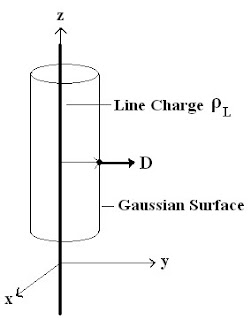Application Of Gauss Law To An Infinite Line & Sheet Charge - Field Theory.
- Consider an infinite line charge carrying a charge per unit length of ρL along the z axis.
- Gaussian surface selected for a symmetric line charge is a hollow cylinder of radius ρ and length l as shown in the figure
- A cylinder has basically three surfaces: top, bottom and the curved cylindrical surface.
From the diagram its clear that
- Electric flux density (D) is parallel to the top and bottom Gaussian surface.
- Electric flux density (D) is normal to the curved cylindrical Gaussian surface.
- Differential surface (ds) is always normal to a surface.
D and ds are normal to each other for the top and bottom Gaussian surface.
Hence
∫ (D . ds) = 0
Hence it’s clear that D and ds are parallel to each other only for the curvilinear Gaussian surface.
- Since the Gaussian surface is a hollow cylinder, hence the variable terms are φ and z. Thus the differential surface for a hollow cylinder is given as:
ds = ∫(φ=0)2π ∫0l (ρ dφ dz) aρ → S = 2πρl aρ
Hence applying gauss law, we have
→ Qenc = Dρ 2πρl = ρL l
INFINITE SHEET OF CHARGE
- Consider an infinite sheet charge carrying a charge per unit surface of ρs on a x-y or z = 0 plane.
- Gaussian surface selected for a symmetric sheet charge can be either a cylinder box or a rectangular box.
- The Gaussian surface is placed such that two of its faces are parallel to the sheet.
- In this case say the Gaussian surface is a rectangular box.
- From the diagram it’s very clear that only two faces of the rectangular box is parallel to the sheet and also parallel to the z-axis.
- Applying Gauss law, we have
- The electric field(E) as well as electric flux density(D) both points away from the plane if ρs is positive and towards the plane if ρs is negative.
- The magnitude of the electric field is a constant – the magnitude is independent of the distance from the infinite plane.
- This is because no matter how far the point is from the infinite sheet, the distance becomes incomparable with the dimensions of the plane. Hence it seems the point is very close to the infinite plane.
ALSO READ:
- Gauss's Law - Theory.
- Gauss's Law - Application To a Point charge.
- Gauss's Law - Application To An Infinite Line Charge.
- Gauss's Law - Application To An Infinite Sheet Charge.
- Gauss's Law - Application To a Uniformly Charged Sphere.
- Numericals / Solved Examples - Gauss's Law.
- Scalar Electric Potential / Electrostatic Potential (V).
- Relationship Between Electric Field Intensity (E) and Electrostatic Potential (V).
- Electric Potential Due To a Circular Disk.
- Electric Dipole.
- Numericals / Solved Examples - Electric Potential and Electric Dipole.
- Energy Density In Electrostatic Field / Work Done To Assemble Charges.
- Numericals / Solved Examples - Electrostatic Energy and Energy Density.
- Numericals / Solved Examples - Gauss's law...
Your suggestions and comments are welcome in this section. If you want to share something or if you have some stuff of your own, please do post them in the comments section.








Comments
Post a Comment